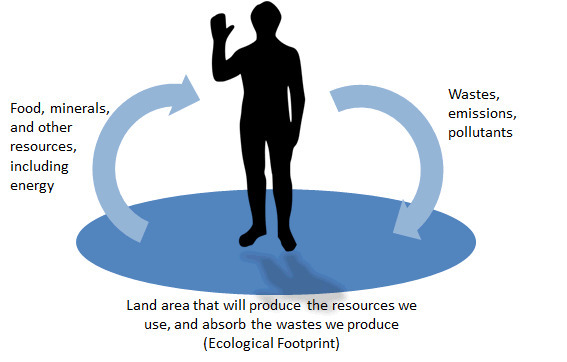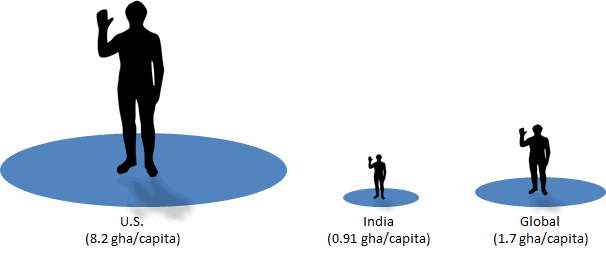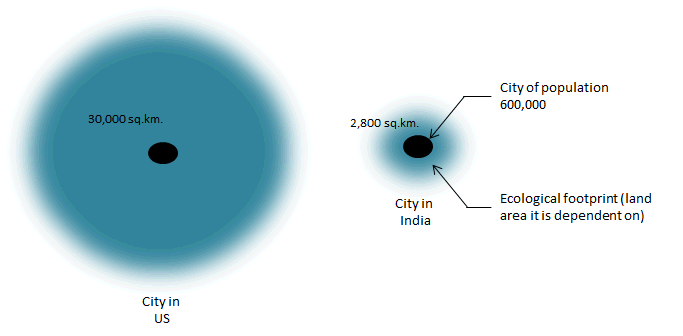The Ecological Footprint of Cities: Innovations For Greater Sustainability
| |||||||||||||||||
Abstract 1. Introduction Since the United Nations Conference on Environment and Development in 1992, population growth and increases in consumption in many parts of the world have increased humanity's ecological burden on the planet, even though the Earth's total natural resources has remained the same. As stated in the Living Planet Report (WWF 2014), the total global consumption of natural resources has risen by 50 percent since 1970, while Earth's natural wealth has decreased by over 30 percent. Global environmental problems are typically considered part of national and international decision-making, it is now becoming increasingly common to also consider the environmental impacts of urban areas, because a rapidly growing proportion of the world's population live in cities. According to the United Nations Population Division, 2.9 billion people or 47 percent of the earth's population lived in urban areas in 2000. In 2007, global urbanization rate reached 50 percent, and will become 60 percent in 2030. In other words, the world's population could increase by 2.2 billion people in 2030, with 2.1 billion of these people living in cities (United Nations 2015). As a response to this, municipal decision-makers must be able to measure urban ecological impacts to inform local environmental policy. One way to do this is through ecological footprint (EF) analysis to understand the impacts of lifestyles , and the natural resources needed for that lifestyle. 2. What is an Ecological Footprint? All of the resources which people use for their daily needs and activities has to come from somewhere, even if not from their immediate surroundings. Food, electricity, and other basic amenities for survival must be taken from nature. Based on this relationship between humanity and nature, an EF measures the amount of arable land and aquatic resources that must be used to continuously sustain a population, based on its lifestyles and consumption levels at a given point in time.
 Figure 1: The Concept of Ecological Footprints
Figure 1: The Concept of Ecological FootprintsIt incorporates water and energy use, uses of land for infrastructure and different forms of agriculture, forests, and all other forms of energy and material "inputs" that people require in their day-to-day lives. It also accounts for the land area required for waste assimilation and CO2 absorption. 3. Scales of Measurement EFs can be measured at an individual level, for cities, regions, countries, or the entire planet. EF analysis can also be used for specific activities, or to measure the ecological requirements of producing specific goods or services. Analysts examine the quantity and different types of natural and manufactured materials and services used, and then use a variety of calculations to convert this into a specific land area. Footprints indicate how much "nature" is available for a defined population to use, compared to how much it needs to maintain its current lifestyles. These materials (and wastes) each demand ecologically productive areas, such as cropland to grow potatoes, or forest to sequester CO2 emissions. All of these materials and wastes are then individually translated into an equivalent number of global hectares (gha ). EFs are calculated using a number of metrics, listed in Table 1
To accomplish this, an amount of material consumed by a person (tons per year) is divided by the yield of the specific land or sea area (annual tons per hectare) from which it was harvested, or where its waste material was absorbed (EDN, n.d.). The number of hectares that result from this calculation are then converted to ghas. The sum of ghas needed to support resource consumption and waste generation of a person gives that person's total EF. 4. Some Global Examples of Footprints Data from 2010 reveals that the per capita EF had exceeded global per capita biocapacity (1.7gha) in 91 of 152 countries. Kuwait, which tops the table, has a per capita EF exceeding 10 gha, while India has a gha of 0.91, much below the global average of 1.7. The US's EF is 8.2 gha. London, UK serves as a good example: the ecological footprint (EF) of the city is almost equal to the land area of UK as a whole. Similarly, a typical North American city with a population of 650,000 would require 30,000 square kilometres of land - about the size of Kerala state. In comparison, a similar size city in India would require 2,800 square kilometres - less than that of Goa.
 Figure 2: Per Capita Footprints of Global, Indian and American Lifestyles
Figure 2: Per Capita Footprints of Global, Indian and American LifestylesCalculations done by the author for Tokyo's EF shows that the megacity alone requires a land area more than three times that of Japan as a whole. Such lifestyles have also resulted in more than 60 percent of its food being imported from overseas (MAFF 2016). 5. Example: India's Footprints
After China and USA, India has the third largest EF in the world. China's share of global EF is a massive 19 percent, followed by USA's 13.7 percent and India at 7.1 percent (WWF 2014) . India's EF has in fact doubled since 1961, exceeded only by the United States and China (GFN and CII, 2008). While India as a whole demands a significant percent of the world's biocapacity due to its huge population, its per-capita EF, 0.91 gha, is smaller than that in many other countries, and well below the world average of 1.7 gha.  Figure 3: Ecological Footprints of Cities
Figure 3: Ecological Footprints of CitiesSince 1961, India's GDP has nearly tripled from $177 to more than $1,200 today. Over that same period, however, the EF of the average individual in India has actually declined by 12 percent, in contrast to other industrializing Asian nations where EFs have increased with GDP. This could be due to uneven wealth distribution, or increasing size of low-income groups. Even with a per capita EF of 0.91 gha, there is a high degree of variability within the country. For example, a study of students in the age group of 17-19 years at Chandigarh's Punjab University found their Footprint to be 5.58 gha. (Raj 2012). 6. EFs' Contribution to Sustainability EF is a data tool that helps us play a more important and direct role in understanding and managing our environment. Is the illustrative data of EFs useful? How would EFs contribute to broader sustainability?
7. Shortcomings of EFs Current EF analyses provide a robust, aggregate estimate of human demand on the biosphere as compared to the biosphere's productive capacity. As with any such calculations, EFs are subject to uncertainty and incompleteness in source data, calculation parameters, and methodological variations. EF analyses are not an exact science, and the values generated are not precise since the quality and quantity of data used play an important role in the resulting EF values.
8. Ecological Footprints and Urban Sustainability Cities play a significant role in global sustainability efforts due to their concentration of population, resources, and impact on the environment. The ecological footprint discussion above highlights the massive negative impacts our lifestyles are having on the environment - whether in terms of food, energy, water or waste. It may be useful to remind ourselves of some of the well-known urban innovations that the concept of ecological footprints can lead to, helping cities achieve greater sustainability. These innovations lie at the core of our impacts on the environment and thus, targets for sustainability action. The innovations include:
References
Wackernagel, Mathis and William Rees (1996), "Our Ecological Footprint: Reducing Human Impact on the Earth". Gabriola Island, B.C: New Society Publishers
Global Footprint Network -
http://www.footprintnetwork.org
Worldwide Fund for Nature -
http://wwf.panda.org/about_our_earth/all_publications/living_planet_report/
Ecological Footprint Calculator -
http://www.earthday.org/take-action/footprint-calculator/
EDN (n.d.) Ecological Footprints. Earth Day Network. Document on the World Wide Web. Document URL: - http://www.earthday.org/take-action/footprint-calculator. Document retrived on 15 March 2016
GFN and CII (2008), "India's Ecological Footprint: A Business Perspective" Hyderabad: Global Footprint Network and the Confederation of Indian Industry.
MAFF (2016), "Monthly statistics of agriculture, forestry and fisheries". Tokyo: Ministry of Agriculture, Forestry and Fisheries
Raj, Sonika et al. (2012), "Ecological footprint score in university students of an Indian city". Journal of Environmental and Occupational Science. 2012; 1(1): 23-26
UNCBD (2006) "Biodiversity - A Global Outlook" United Nations Convention on Biological Diversity (UN CBD)
United Nations (2015), "World Population Prospects". New York: United Nations Population Division
WWF (2914), "Living Planet Report 2014: Species and Spaces, People and Places" Worldwide Fund for Nature.
Wackernagel, Mathis and William Rees (1996), "Our Ecological Footprint: Reducing Human Impact on the Earth". Gabriola Island, B.C: New Society Publishers
|
|||||||||||||||||
|
|

